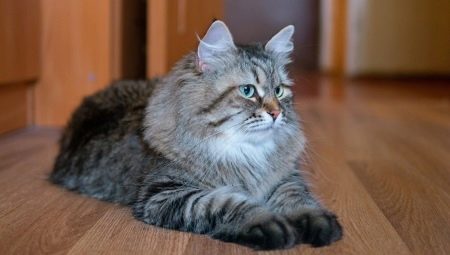Siberian cat is a breed of unique beauty that does not lose popularity among cat lovers around the world. Luxurious wool and noble appearance tie the hearts of owners, attracts attention at exhibitions. Many breeders consider Siberians to be a visiting card of Russia, highlighting smoky and gray animals.
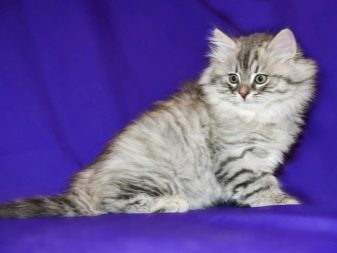
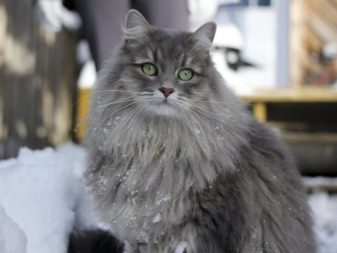
Origin
Among experts in the field of felinology, disputes about the origin of the breed do not subside. According to one version, a beautiful animal was originally imported from Asia with caravans of merchants in the 16th century. After adaptation and mixing with other representatives of the feline family, a look of a “Bukhara” cat appeared, which was repeatedly mentioned by classics in works about Siberia and the Urals.
Studies have shown that Siberian cat may have genetic ties with Persian and Angora breeds. But the severe frosts of the Siberian climate really influenced the density and beauty of the coat. The first participation of the fluffy beauty in the exhibitions dates back to 1871, from which the breed is monitored. A full description of the standard was made only in 1990, when breeders and official clubs appeared.

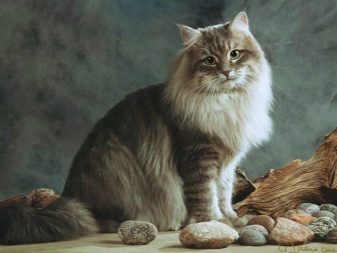
Breed Business Card
According to the recognized WCF standard, gray Siberian cats have the following features and characteristics.
- A large and muscular body, which is distinguished by its power and proper structure. The normal weight of the cat reaches 8–12 kg, and the female rarely exceeds 6–8 kg.
- At the withers, the animal reaches a height of at least 30–40 cm.
- It takes several years to develop and gain mass, so breeders are in no hurry to mate animals before 2 years.
- The trapezoidal shape of the head, corresponding to the large body of the animal. She is surrounded by a luxurious collar of thick wool, giving the cat a solid look.
- The ears are widely spaced, which makes Siberians excellent hunters with unrivaled flair.
- Among the claws on the paws there are small islands of wool that prevent freezing of the delicate skin. Paws are large and proportional to the body.

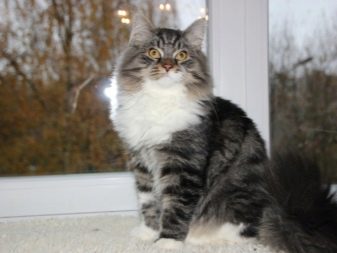
Due to the formation of the breed in a frosty climate, nature has gifted a Siberian gray cat with amazing hair. This is a real fur coat, consisting of a long pile and dense undercoat. She not only protects the cat from the cold, but also creates an amazing volume. Particularly noticeable is the length on the tail, which is incredibly fluffy and graceful.
Among the positive qualities of a Siberian cat is the almost complete absence of enzymes, which, when isolated on wool, provoke an allergy in humans. This allows us to consider the breed hypoallergenic.
Cats are calm and positive, get along well with other animals and become favorites of the whole family. But the animal is distinguished by a love of equal treatment: they do not tolerate attacks on their territory, frequent hugs and coercion to play.
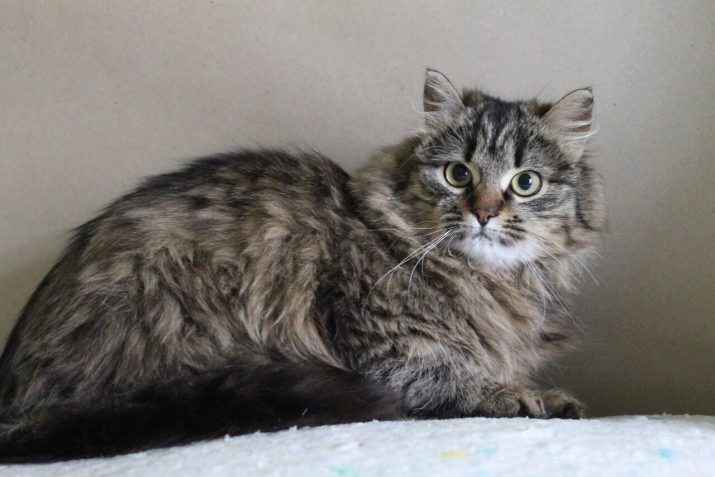
Many owners note that the pets have not lost the forest hunter's natural curiosity. They are happy to explore the premises, inquisitive and find "adventure" on their fluffy tail. Therefore, breeders recommend from the first days of the appearance of a Siberian kitten in the house to engage in his education, to accustom to order and a certain regime.
Types of gray color
Among the numerous colors of Siberian cats, according to the standards of world organizations, the following are distinguished.
- Solid or solid. The cat's coat is dyed in one tone, has no spots or stripes.
- Bicolor. The animal has several shades of gray, dyed hairs on the tail and over the entire surface of the fur coat.
The most beautiful and noble cats are cats of smoke color, which have repeatedly occupied leading places at high-level exhibitions. They have bright eyes with a golden or blue tint. The coat is smoky gray, darkening towards the tip of the villi. The undercoat remains whitish, glows from the inside, giving an additional visual volume.
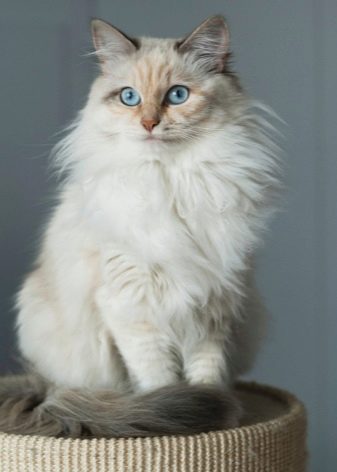
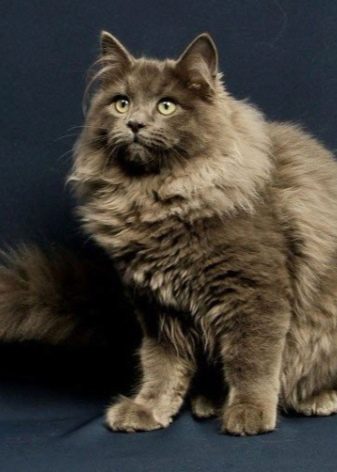
Gray shade is sometimes called "blue" for an unusual tint in the light. This is a beautiful view of Siberian cats with bright yellow eyes. The brighter the contrast between the light undercoat and the main pile, the higher the cost of the kitten in the litter. The tone becomes darker over time on the ears, legs and upper line of the tail.
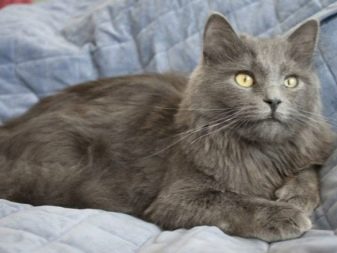
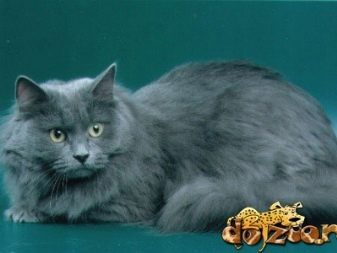
An unusual gray color of a Siberian cat is silver chinchilla. Nature has formed a unique hue due to the presence of specific melatonin in the gene. He stains long villi only at the tips, which contrasts with the white undercoat.
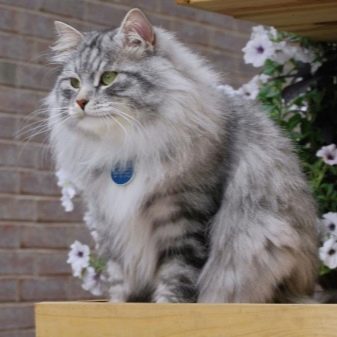
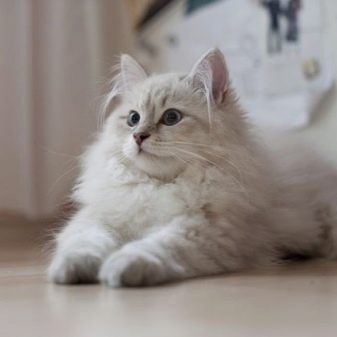
Cat Care and Health
To preserve the beautiful appearance of a fur coat, comb your pet 2-3 times a week with a special brush. When signs of molting appear, the procedure is repeated every day, using sprays if necessary to improve the quality of the coat. Siberian cats love water procedures, so once in 3-5 months they can have a bath with shampoo.
The nutrition of the Siberian cat must be given due attention. The health of the animal and the condition of the coat depend on its quality. The daily menu includes:
- protein in the form of meat and fish of low-fat varieties, boiled fillet in the range of 120–140 g;
- dairy products, cottage cheese, fat-free kefir;
- cereals on the water mixed with seafood or meat;
- boiled vegetables in the form of mashed potatoes or small pieces (zucchini, carrots, white cabbage).



With such a balanced diet, a Siberian cat does not need additional vitamin complexes.
In a small amount it can be "pampered" with chicken liver, boiled eggs, a slice of fresh cod or crucian carp.
The gray color of the Siberian cat makes any changes in nutrition noticeable: with a lack of vitamins, the smoky tone fades and becomes faded. During this period, it is necessary to increase the number of vegetables, mixing them with meat. The excellent health of the breed with proper nutrition makes pets real centenarians, without giving owners much trouble.
Interesting facts about Siberian cats can be found in the next video.
